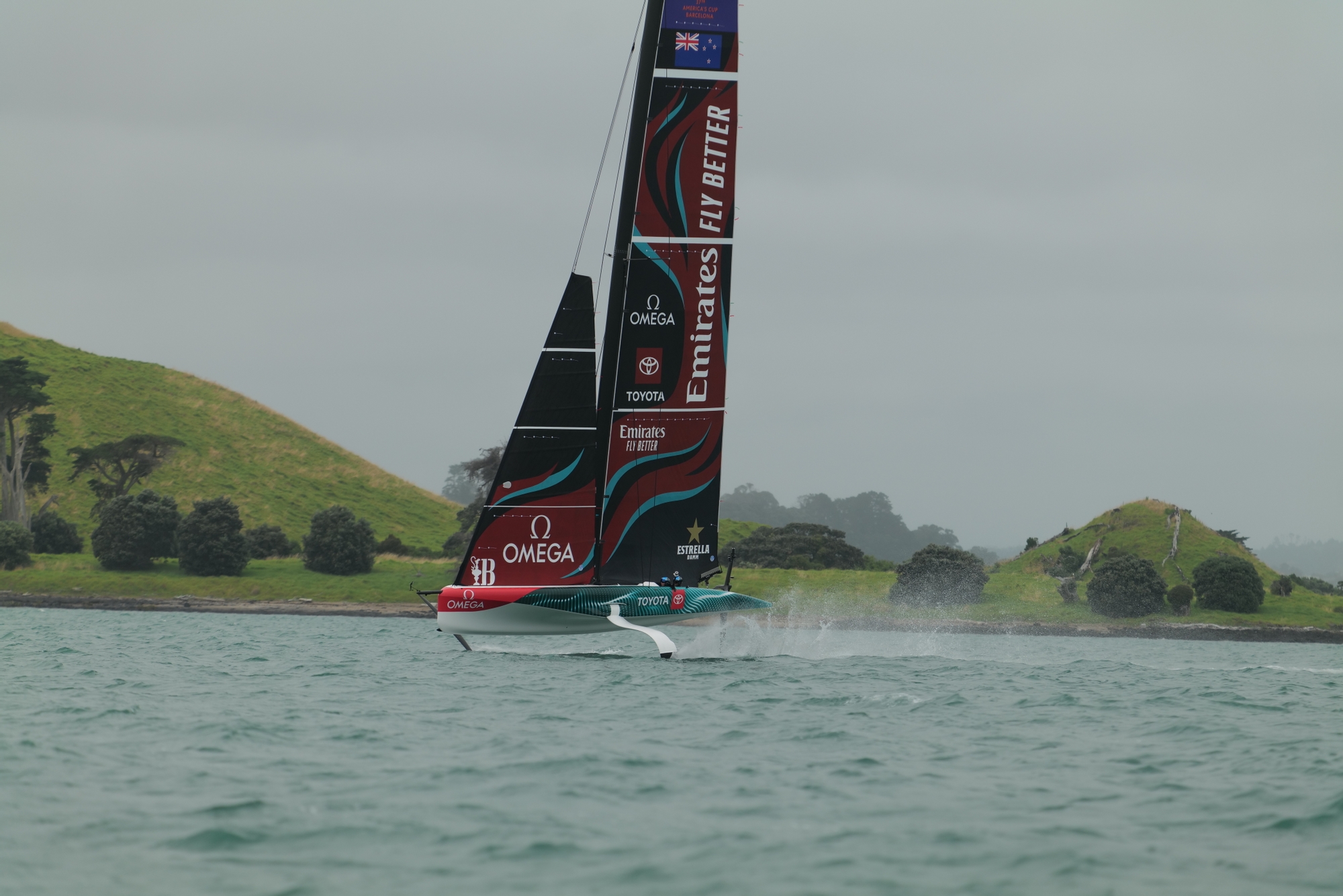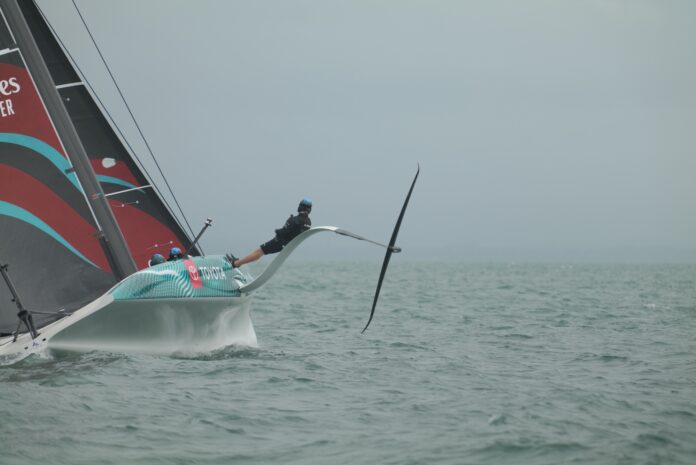Emirates Team New Zealand’s shore team showcases exceptional skill and dedication, swiftly resolving challenges overnight to ensure the seamless operation of the LEQ12-modified AC40, reaffirming their commitment to top-tier performance in America’s Cup preparations.
For the sailing team, they were presented not only with a fully tricked-up LEQ12 but Auckland summer conditions of 26 degrees and completely overcast with rain squalls and a solid breeze that peaked up at 20 knots+ in the afternoon. Sea state was lumpy so this was upper-range conditions and a real test for the new Wing04 on the starboard foil arm and an even sterner test for the Flight Controllers/Trimmers charged with dealing with an asymmetric set-up from port to starboard.

What was noticeable with the new foil is the level of comfort that the team built in over the course of a dynamic, full pressure, high intensity session as Pete Burling and Nathan Outteridge began driving the boat like they stole it. Fast bear-aways, even faster round-ups, the data analysts would have been whooping with the numbers coming back.

Downwind, especially going from starboard gybe onto port, the new foil looked to have a lower exit and Nathan appeared to be wanting to push it lower and lower. Upwind, the cant angle was simply enormous, almost out at 45 degrees to give a super low-ride and bring the hull desperately close to the surface but still with the ability to trim up on the ride height over the waves.


Sail trim was, as usual, bang on point with the current trend of only using minor traveller adjustment (although constant) and keeping more pressure on the leech through mainsheet adjustment. Downwind this is accentuated with a floppy forestay but observable leech flicks via the mainsheet to keep the power on. Massively impressive sailing from the Defenders of the 37th America’s Cup over the two-and-a-half-hour session that was mesmerising to watch.


Speaking afterwards, Performance Engineer in the Aero and Hydro Division, Simon Corkery gave a good analysis of the day and what the team were looking to achieve saying: “Well it’s obviously a brand-new foil on the boat. There’s been a few minor issues that we’ve had with it over the past couple of days which you know caused us to come in earlier the other day, so today it was really about just pushing the foil to the limit seeing that it’s going to hold out for the entire range of conditions that we could expect the thing to suffer through. And today was a pretty good day because it basically survived, and we came back when we intended to….It’s working well but that’s one of the challenges of our job. All the conditions are super nice and perfect on the computer but when you come out and actually sail and then you’re ploughing through waves getting data which is actually representative of what you have on the screen it’s extremely challenging, so we do our best and so far that foil seems to be doing a pretty good job.”



Talking about the challenge for the sailors of handling two quite different foil and flap set-ups on the LEQ12, Simon added: “The two foils tend to perform in slightly different ways so it’s always a bit challenging for the guys to changeover between one foil to the other foil and then also see how each one responds during these challenging conditions, it’s pretty tough for them.”


And looking forward to the upcoming decisions that will have to be made on the foils, Simon gave a very interesting insight into the process that all the teams will be facing now, saying: “That’s always a hard one to say so I mean our sailors and a lot of the other teams will be trying to weigh up how big the foils need to be and things like the planform shape that they may have and then often the choice comes down to I guess personal preference in terms of what the teams actually targeting – the bigger foils perform better in the light and they help to take off, but then they generally have a whole lot more drag when you’re going in the upper wind range so it’s a challenging time of year for all the designers, sort of crunch time now.”
Crunch time indeed. Plenty more sailing and detailed analysis to come though before Emirates Team New Zealand locks in their decisions. (Magnus Wheatley)
On-Water Recon Report – Emirates Team New Zealand: ETNZ Day 56 dock out occurred at 11:15. Weather today was overcast with scattered showers and a gradient breeze from ENE which tended NE as the session transpired. Sails were hoisted off Mechanics Bay at 11:30, the team initially opting for the M2-3 main and J2-2 Jib. The J3-2 was interchanged 30 minutes later however, as the breeze built.
The initial part of the session took place in the flatter water from North Head to Browns Island in the lee of Rangitoto Island. Over the last few days, the team gave the impression that they were struggling, at times, with the control of the new starboard foil. So it seemed that they were keen to warm up and ease into testing in the flatter water. After 30 minutes of sailing, the team appeared very comfortable. All manoeuvres were fully foiling, and they could be seen running some decent cant angles on the new foil and really starting to load it.


At 12:01 the team changed to the smaller J3-2 Jib as the breeze had significantly increased. It was averaging around 15 knots by now. After the change, the team practiced in the lee of Rangitoto for another 30 minutes before heading out passed Rangitoto Light House into some decent sea state which we predicted to be between 0.8m – 1.2m at times.
It looked as though the team was really trying to push the limitations of the boat and new starboard foil out in this sea state. Except for two failed manoeuvres, because of bad timing through waves, the boat, foil and team performed very well. The only real shakiness could be seen on the exit of higher speed gybes onto the new foil. It was obvious they were still not super confident with controlling this foil on the exits at high speed.
After short upwinds and downwinds in this larger sea state and breeze up around 20 knots at times, the team decided to bear away and head back to base. This bear-away was the first seen on the starboard foil today and was completed very successfully.
While on port sailing back toward North Head, the team carried out a few round-ups and bear-aways on the new foil, obviously becoming confident enough to start pushing its limits. There were no issues seen and each manoeuvre was successful.
The team arrived back at Mechanics Bay at 13:35 where they displacement rounded-up and dropped sails to end a very successful higher-end training day.


SAM THOM / AMERICA’S CUP


SAM THOM / AMERICA’S CUP










